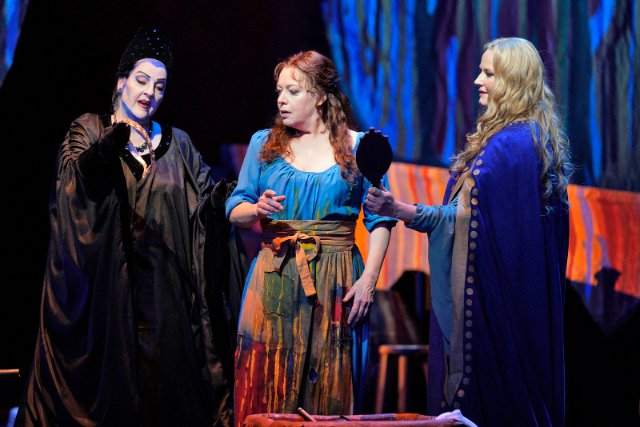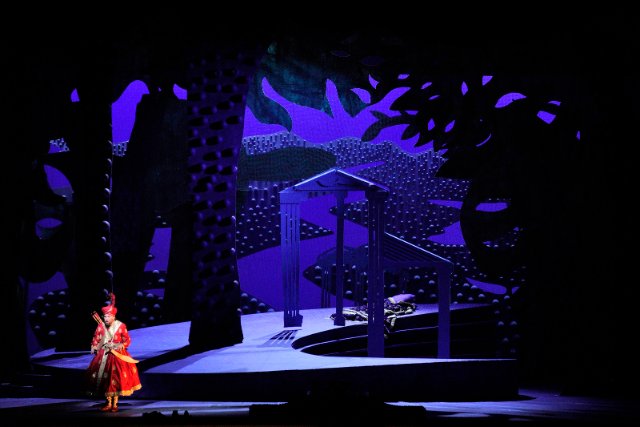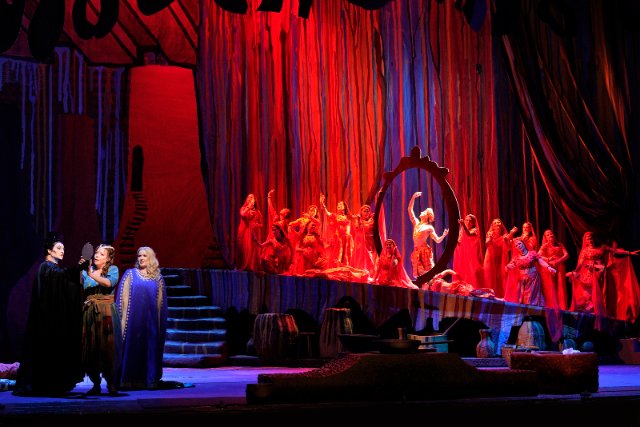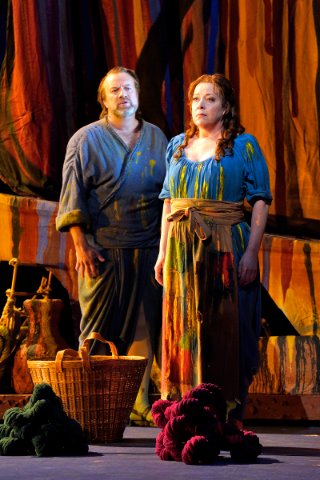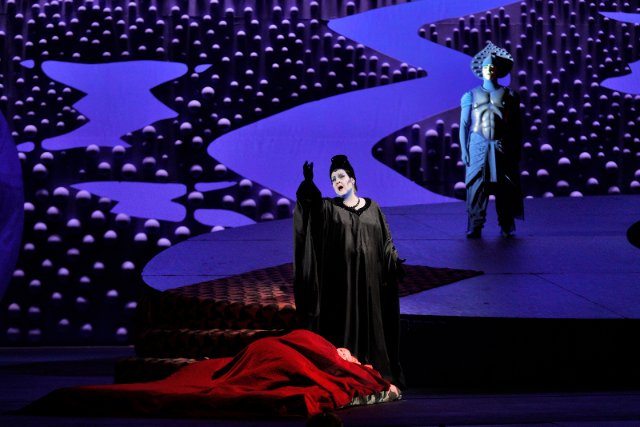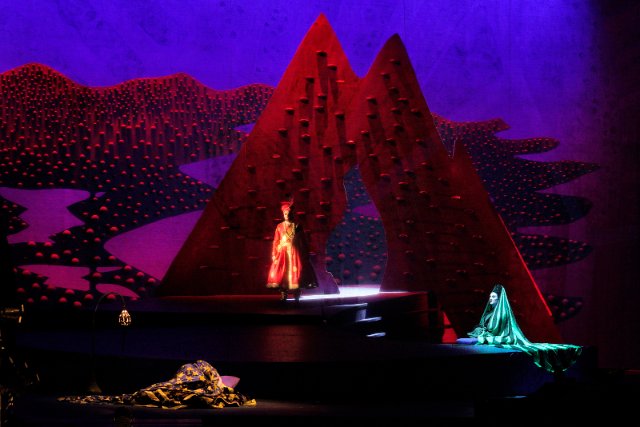Die Frau ohne Schatten
Richard Strauss's Lush Music, Captivating Fairy Tale Story, and Pop Art Scenery.
By: Victor Cordell - Jun 12, 2023
After a 34-year absence from its stage, San Francisco Opera triumphantly offers the opera that represents the culmination of Richard Strauss’s most productive period. This demanding opera is imbued with lush music; tells a captivating fairy tale story; and in the current production, visually explodes in pop art scenery. Following his masterpieces “Salome,” “Elektra,” “Der Rosenkavalier,” and “Ariadne auf Naxos,” it is “Die Frau ohne Schatten” – the woman without a shadow. In this case, lacking a shadow symbolizes a woman being barren.
Hugo von Hofmannsthal’s complex libretto can confuse. The Empress of a fictional empire is ordered by her father, the King of the Spirit Realm, to acquire a shadow within three days. If she fails, she will be forced to return her father, and her husband, the Emperor, will be turned to stone. Aided by her nurse, the Empress descends upon a yarn dyer’s wife in the human world who has chosen not to have children. The Empress promises unimagined riches and luxury in return for the poor woman’s shadow. Though the lyrics from the backstage chorus say that the narrative is about love, the action, particularly by the males, is not romantic but about producing heirs. The Dyer’s Wife even scolds the Dyer by decreeing that he doesn’t “own” her.
In the end, the Empress faces Sophie’s choice. Either decision - to accept or reject the shadow - could leave blood on her hands. High drama occurs with perceived or real betrayals and threats of killing, but since nobody dies, some would characterize “Die Frau” as a comedy!
Not only does this opera build upon Strauss’s own oeuvre, but it reveals its foundations in Mozart and Wagner. The fairy tale and its challenges draw on “The Magic Flute.” However, in Mozart’s opera it is the men who face the trials of courage. Almost uniquely, in Strauss’s, the women are tested.
Like Wagner, Strauss exacts exceptional beauty and strength from instrumental music, also magnified by an exceptionally large orchestra. Conductor Donald Runnicles demonstrates total command over a pit of 96 musicians. Also, like late-period Wagner, vocalization tends toward the highly dramatic with little in the way of hummable melodies. Set pieces are rarely memorable, though the final scene’s duets and quartet do impress. And in keeping with Strauss being the most suitable successor to Wagner, “Die Frau” is replete with leitmotifs. Often leitmotifs are redundancies as the audience already sees the character associated with the musical phrase. Here, the two most recognizable leitmotifs are of the Falcon and the Empress’s father, Keikobad, neither of which we ever see. In a final similarity, at over three hours and forty minutes for a performance, this masterpiece is somewhat bloated, customary in late-period Wagner.
Strauss loved the female voice. Just look at the titles of the operas mentioned in the first paragraph. Like the earlier “Der Rosenkavalier,” three female voices dominate, two sopranos and one mezzo. But while the earlier opera demanded mostly lyrical singing to ethereal music, “Die Frau” calls for dramatic vocalization to cut through large orchestration, and this cast possesses three outstanding practitioners.
The key role is the Dyer’s Wife, who like four of the five leads is not given a name. This part is portrayed by Nina Stemme, who on opening night received the San Francisco Opera Medal, the company’s highest honor. She gives a memorable performance powering her way through both ends of her range with despair, rage, and rejoicing, as a woman confronted by many obstacles. Her dilemma is whether to accept the consequences of selling her shadow, in the knowledge that she has resisted using it, but knowing that her husband wants children.
Camilla Nylund impresses as the Empress. Like Stemme, she is a dramatic soprano, perhaps a little lighter vocally but in a role with a higher range, which she handles skillfully. Unlike some mythical treatments from literature, “Die Frau” contains no sociological messages, but rather challenges of personal character. It is the Empress who undergoes the greatest test of personal integrity, knowing the possible destruction of the Dyer’s Wife in one case or the Emperor in the other.
The third female principal is the versatile Linda Watson in a mezzo role, though she has succeeded in a large dramatic soprano repertory as well. She plays an archetypical figure, the Nurse who acts as companion to the Empress. She is older, dour, and often manipulative. She also possesses magic which is used to accomplish her objectives. Her darker, imperious voice holds up well alone and in vocal collaboration with the other women. Bass-baritone Johan Reuter as Barak, the Dyer, and David Butt Philip as the Emperor have smaller roles but fill them admirably.
Another star in the production is the staging. David Hockney’s well-traveled abstract designs have stood the test of time. In the Spirit Realm, the masses of small hemispheres on the back wall change perspectives of size and depth with alterations in Justin A. Partier’s colored lighting to create a preternatural pop art look. In the human world, the stage is a veritable kaleidoscope of brightly colored curtains with paint drips defining the Dyer’s work shop and abode. Add Ian Falconer’s brilliant, predominantly Indian-themed costumery, and the stage bursts with energy throughout.
Done properly, few opera companies can produce “Die Frau ohne Schatten” as it hogs resources. It demands a huge orchestra, a large chorus, sets to accommodate several locales, and infrastructure to facilitate numerous scene changes quickly. San Francisco Opera patrons are fortunate to have the opportunity to witness this grand opera.
“Die Frau ohne Schatten,” composed by Richard Strauss with libretto by Hugo von Hofmannsthal; is co-produced by San Francisco Opera, LA Opera, and Royal Opera House Covent Garden; and plays at War Memorial Opera House, 301 Van Ness Ave., San Francisco, CA through June 28, 2023.

